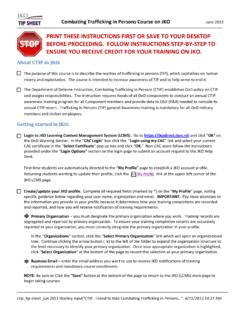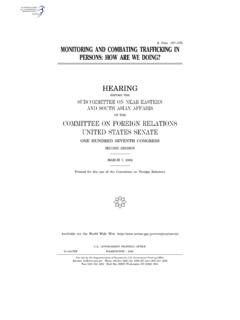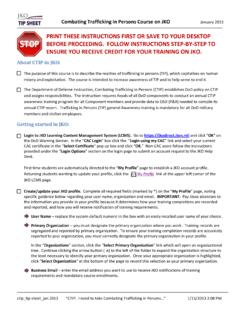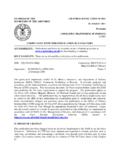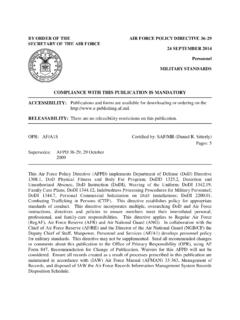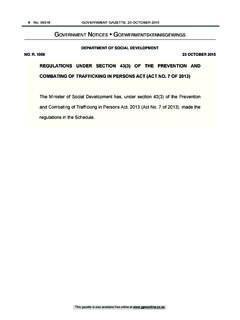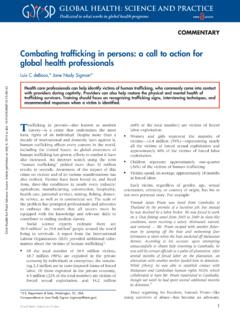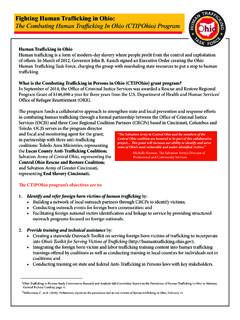Transcription of COMBATTING TRAFFICKING IN PERSONS (CTIP) TRAINING …
1 COMBATTING TRAFFICKING IN PERSONS (CTIP) TRAINING COURSE Anti-Human TRAFFICKING TRAINING Manual COMBATTING TRAFFICKING IN PERSONS (CTIP) CAPACITY DEVELOPMENT COURSE AND PROFESSIONAL CERTIFICATE PROGRAM Editor, Marco Tavanti, Associate Editors: Elizabeth Wilp, Alyssa Rickman World Engagement Institute & Sustainable Capacity International Institute Copyrights 2014: Reproduction and distribution of this manual outside of personal and fair use requires a written authorization. Please contact CTIP-WEI-SCII 3 TABLE OF CONTENTS Module 1 5 HUMAN TRAFFICKING Module 2 11 CHILD TRAFFICKING Module 3 18 LABOUR TRAFFICKING AND DOMESTIC WORKERS Module 4 24 ORGAN TRAFFICKING Module 5 28 SEX TRAFFICKING Module 6 31 PREVENTION Module 7 34 PROTECTION Module 8 40 PROSECUTION Module 9 44 PARTNERSHIPS Module 10 48 REINTEGRATION Module 11 51 SOUTHEAST ASIA AND THE PHILIPPINES Module 12 60 CALL TO ACTION CTIP-WEI-SCII 4 ACRONYMS A-HT Anti-Human TRAFFICKING ADU Adamson University Asia-ACT Asia Against Child TRAFFICKING BI Bureau of Immigration CBCP Catholic Bishop Conference of the Philippines CEAP Catholic Education
2 Association of the Philippines CFO Commission on Filipinos Overseas CHR Commission on Human Rights CTIP COMBATTING TRAFFICKING in PERSONS DFA Department of Foreign Affairs DILG Department of Interior and Local Government DOJ Department of Justice DSWD Department of Social Welfare and Development ECPAT End Child Prostitution, Child Pornography and the TRAFFICKING of Children for Sexual Purposes IACAT Inter-Agency Council Against TRAFFICKING IGO Intergovernmental Organization IJSHS International Journal of Sustainable Human Security ILO International Labour Organization INGO International Nongovernmental Organization IOM International Organization for Migration NCFRW National Commission on the Role of Filipino Women NFP Not For Profit Organization NGO Non-governmental Organization OWWA Overseas Workers Welfare Administration PNP Philippine National Police POEA Philippine Overseas Employment Administration PREDA People's Recovery.
3 Empowerment Development Assistance Foundation SCII Sustainable Capacity International Institute SMC Scalabrini Migration Center TAF The Asia Foundation TIP TRAFFICKING in PERSONS TUCP Trade Union Congress of the Philippines TVPA TRAFFICKING Victims Protection Act TW-MAE-W Third World Movement Against the Exploitation of Women UNHCR Office of the United Nations High Commissioner for Refugee UNICEF United Nations International Children Education Fund UNODC United Nations Office on Drugs and Crime UNTOC United Nations Convention against Transnational Organized Crime US-DOS United States Department of State USAID United States Agency for International Development VFF Viasayan Forum Foundation WEI World Engagement Institute CTIP-WEI-SCII 5 MODULE 1 HUMAN TRAFFICKING OBJECTIVES 1.
4 Define human TRAFFICKING in its various aspects and typologies 2. Understand the three constituent elements of human TRAFFICKING 3. Recognize and analyze the systemic, economic, educational, cultural, religious and other elements in relation to human TRAFFICKING . INTRODUCTION Human TRAFFICKING is a billion dollar business1 one that affects every country in the world. The supply side of TRAFFICKING in PERSONS is influenced by environmental, economic, social, cultural and political factors including, poverty, corruption, weak rule of law, political oppression, a lack of human rights, gender stratification, dislocation and institutional factors2. The United Nations organizes the demand for labor or sex TRAFFICKING to include employer demand (employers, owners, managers), consumer demand (clients, corporate buyers, household members), and third party enabling (recruiters, agents, transporters).
5 By understanding all dimensions influencing or influenced by human TRAFFICKING we can better develop sustainable, human rights solutions. CONTENT The act of human TRAFFICKING , also known as, TRAFFICKING in PERSONS (TIP) is defined in the 2000 Protocol to Prevent, Suppress and Punish TRAFFICKING in PERSONS , Especially Women and Children, Supplementing the United Nations Convention Against Transnational Organized Crime ( TRAFFICKING Protocol) as:3 the recruitment, transportation, transfer, harbouring or receipt of PERSONS , by means of the threat or use of force or other forms of coercion, of abduction, of fraud, of deception, of the abuse of power or of a position of vulnerability or of the giving or receiving of payments or benefits to achieve the consent of a person having control over another person, for the purpose of exploitation.
6 Exploitation shall include, at a minimum, the exploitation of the prostitution of others or other forms of sexual exploitation, forced labour or services, slavery or practices similar to slavery, servitude or the removal of organs. 1 (ILO. 2009. The Cost of Coercion (Geneva, Switzerland) 2 USAID. CTIP Field Guide. April 2013 can be found at USAID. CTIP Field Guide. April 2013 can be found at 3 Find this information at TRAFFICKING in PERSONS Report, 2013. CTIP-WEI-SCII 6 TRAFFICKING Protocol, article 3(a)4 Article 3 of the TRAFFICKING Protocol explains that TRAFFICKING in PERSONS has three constituent elements: (1) An act (what is done); (2) The means (how it is done); and (3) Exploitative purpose (why it is done).)
7 In criminal law terms, the TRAFFICKING Protocol categorizes these three constituent elements into two categories: (1) actus reus and (2) mens rea. Actus reus involves the material or physical element(s) of human TRAFFICKING and it must include recruiting, transporting, transferring, harboring, or receiving a person. The offense must also contain: use of force, threat of force, coercion, abduction, fraud, deception, abuse of power, and giving or receiving benefits to truly be considered TRAFFICKING in PERSONS . The second category, mens rea, is the mental element of human TRAFFICKING . According to the 2000 TRAFFICKING Protocol, this category of the crime is most often the hardest to judge and convict because only those with a sufficient guilty mind can be found liable for a criminal offence.
8 What Human TRAFFICKING Is Not While the following elements are not considered to be forms of human TRAFFICKING , they are considered to be extreme forms of exploitation and are in clear violation of basic human rights. These elements include: 1. Illegal adoptions 2. Child Pornography 3. Societal Elements of Human TRAFFICKING As human TRAFFICKING is not just a crime, but is also a profitable business and a culturally legitimized phenomenon, we need cross-sector and multidisciplinary TRAINING programs to understand and combat the complex and multifaceted dimensions of human TRAFFICKING . The business of human TRAFFICKING embodies a demand and supply chain for both labor and sex.
9 First, the third party enabler, such as, recruiters, agents, and transporters lure their victims away from their previous life and into a life of darkness. The employer demand includes the employers, owners and managers of brothels, sweatshops, and hostile domestic labor entities that house and exploit the victims. These employers gain their profit by selling men, women, and children to a consumer, such as, clients, corporate buyers, and household members. After the profit is made, the exploitive process begins again. Significant comprehension of TRAFFICKING in PERSONS in an international context involves not only understanding the supply and demand aspect of the act, but also the complex integration of 4 The TRAFFICKING Protocol is available at 5 This language comes from, DOS.
10 2010. TRAFFICKING in PERSONS Report (10th Edition). Washington, CTIP-WEI-SCII 7 multiple societal elements, including systemic, economic, cultural, educational and religious that play a crucial role. It is within these societal elements that the solution to end human TRAFFICKING lies. Some examples of these interwoven societal elements include poverty, corruption, lack of human rights, gender stratification, dislocation, weak rule of law, and political oppression. It is the heart of these issues that human TRAFFICKING thrives, and it is being able to fully understanding the influential power of these factors that will provide insight into sustainable solutions to human TRAFFICKING worldwide.
